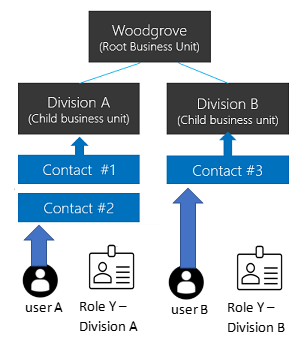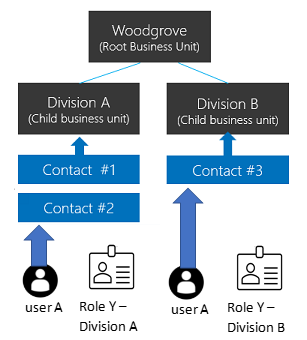Modernize Business Units enables Dynamics 365 users to own records across business units. For years, sharing and holding records across business units was a requirement for many clients who want, for example, to be able to get one of their salesmen to own an account across the border. In contrast, their business units are divided geographically. In such cases, We used to either restructure the business units or come up with other solutions such as sharing the records or using access teams. Now, we can utilize Modernize Business Units to allow users to own records directly across business units.
For more information about Dynamics 365 security models and concepts, check Microsoft’s documentation.
Business units and owning business unit field
Business units are the building block of the security model. Meaning, The users who belong to a business unit by default the users’ records are owned by their business unit.’
Owning business unit field is a lucked field on each table record. This field is set, as explained earlier, based on where the owner of the record exists. See the example below.

To illustrate, as in the above snapshot, I made the owning business unit field visible on the form. Once I change the owner of the record in Dynamics 365 to a new owner in a different business unit, the owning field will be updated automatically to point out to the new user’s business unit.
Hierarchical data access structure
To understand Modernize Business Units work, we need to be fully aware of how the hierarchical data access structure works first.
As shown, each business unit that we can build has to have a parent business unit in a hierarchical structure. By default Dynamics, 365 comes with the central business unit that can be the leading organization. Then we can create Division A and Division B as business units.
IN THE EXAMPLE, User A and User B were given the same security role Y. However, their access to their business unit is limited according to the privileges role Y is giving them. But most importantly, they cannot own any records from the opposite business unit. User A can own contact own #1 and contact #2 but cannot be assigned the owner for contact record #3. The same rule applies to user B, located in the business unit “Division B.
Also, we are required to know that if we move a user to another business unit, all related records will follow the user to his new business unit.
Modernize Business Units
The newly introduced approach or “modernize business units”, as Microsoft calls it, allows users to own records outside of their business units.
This feature has great usability in many implementations. For example, a sales organization operates internationally across many countries and wants to structure its business per country or region. However, they have global organizations that want to appoint and sign a single account manager to all their offices globally. Now using “modernize business units”, they can!
The example to the right shows, user A owns contacts in business unit “Division A” where he is located and at the same time holds contacts across other business units “Division B” using the same role “Y”.
Enabling matrix data access structure
Matrix data access structure is still in the preview stage, and my trial Dataverse environment is not yet rolled out. I will be posting soon on how to enable the matrix data access structure.
However, I believe that this new feature will give us the flexibility to fulfil clients’ requirements, especially with new implementations.




